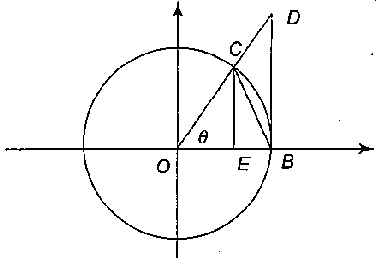Question
Question: Prove that \[\sin \theta < \theta < \tan \theta \] for \[\theta \in (0,\dfrac{\pi }{2})\]....
Prove that sinθ<θ<tanθ for θ∈(0,2π).
Solution
We will consider a unit circle to prove our given equation. Then we consider a two triangle as per our own interest to find the values of sinθ and tanθ.
Complete step-by-step answer:

Here we are trying to consider a circle with unit radius with the centre at the origin.
Then we choose a point C on the circumference and another point B on the intersection of the circle and the x axis. Then we draw a perpendicular line from B which is parallel to y axis. We join OC with the perpendicular line in a point D.
Now, the point C is given at random,
From the figure, for any position of C on the circle,
Area of ΔOBC < Area of sector OBC< Area of ΔOBD
Using the corresponding formulae, the area of the triangle, 21.height. base
so, area of \Delta OBC$$$$ = \dfrac{1}{2}.CE.OB, where CE is the height of the triangle of ΔOBC
and area of \Delta OBD$$$$ = \dfrac{1}{2}.DB.OB
and the area of sector OBC, = 21. Angle made by the sector OBC. =21.θ
so, now we have,
=21.CE.OB<21.θ<21.DB.OB
As, for the triangle OCE, sinθ=OCCE=1CE=CE
And for the triangle ODB, tanθ=OBDB=1DB=DB
As, OC=OB=1as this is a unit circle,
=21.sinθ.1<21.θ<21.tanθ.1
Cancelling out from 21 all of them, we get,
=sinθ<θ<tanθ for θ∈(0,π/2)
Note: In some cases we have also sinθ=θ.The small-angle approximations can be used to approximate the values of the main trigonometric functions, provided that the angle in question is small and is measured in radians.
